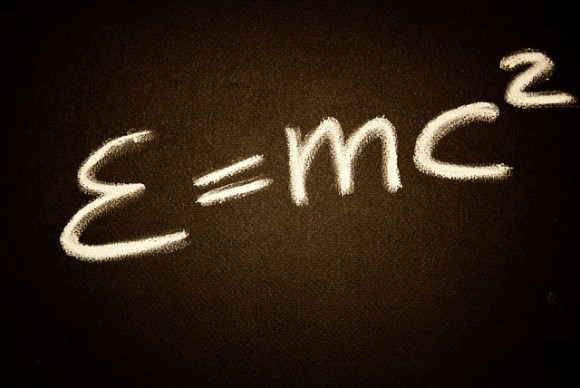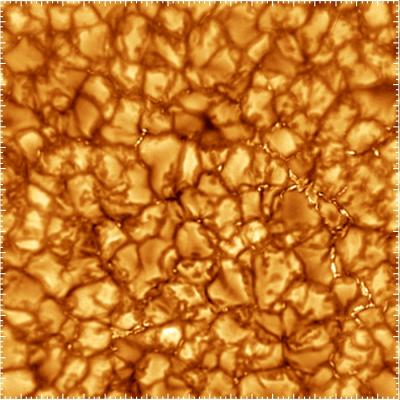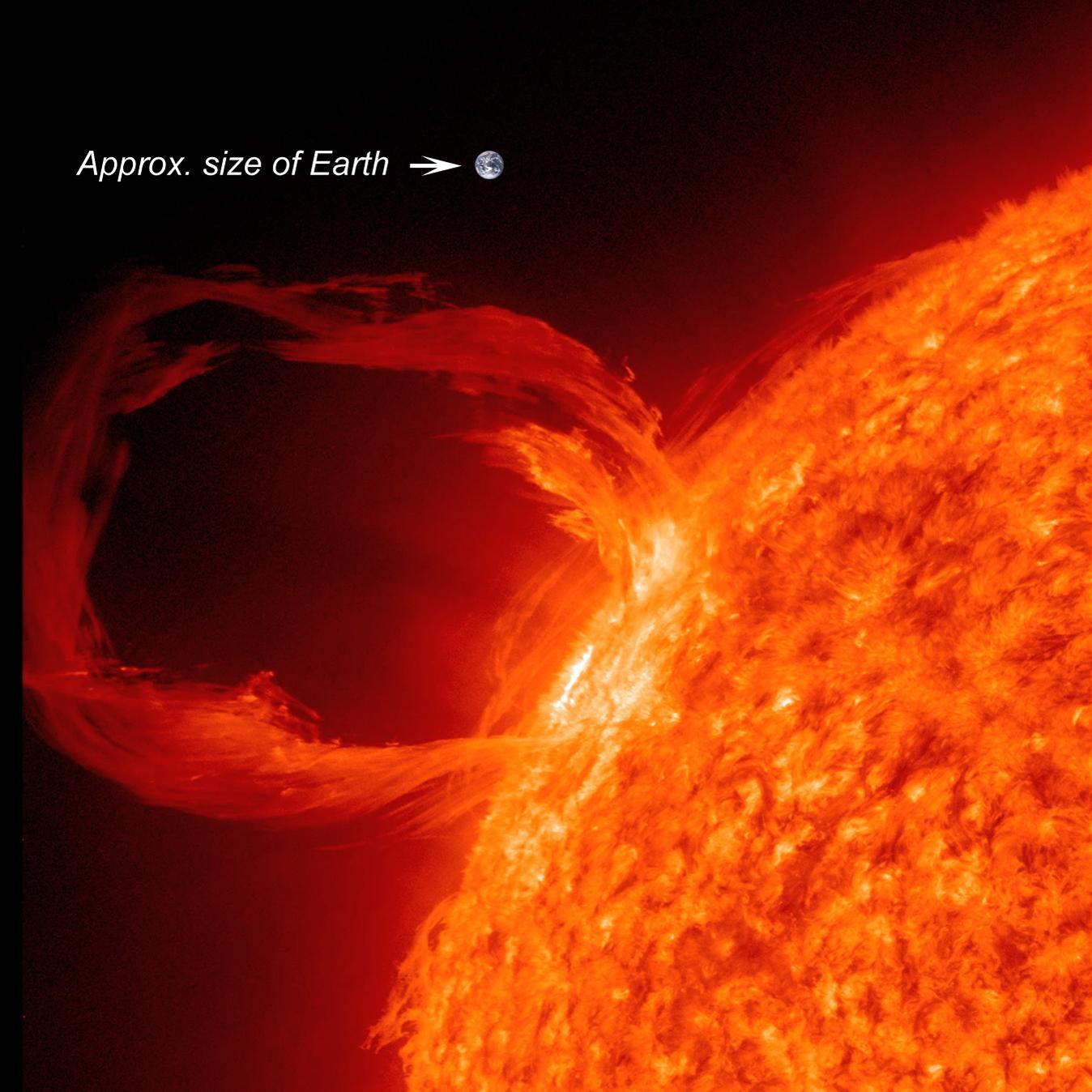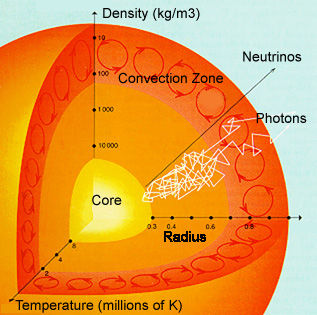THE SOUTHWORTH PLANETARIUM
207-780-4249 www.usm.maine.edu/planet
70 Falmouth Street Portland, Maine 04103
43.6667° N 70.2667° W
Altitude: 10 feet below sea level
Founded January 1970
Julian Date: 2458985.16
Julian Date: 2458985.16
2019-2020: CXLVIII
THE DAILY ASTRONOMER
Friday, May 15, 2020
Friday, May 15, 2020
Remote Planetarium 35: Week 7 Quiz
We are all about the Sun this week: its birth, energy generation mechanisms, as well as its inner and outer layers. Before we set sail for the Universe beyond the solar system, we offer this quick quiz about our closest star.
1. What fundamental force is responsible for keeping two protons from merging?
a. gravity
b. electromagnetism
c. the weak nuclear force
d. the strong nuclear force
2. According to the Ideal Gas Law, when pressure increases what else increases?
a. temperature
b. mass
c. atomic number
d. none of the above
3. What is the weakest of the fundamental forces?
a. gravity
b. electromagnetism
c. the weak nuclear force
d. the strong nuclear force

4. In the equation above, what does "c" represent?
a. energy
b. mass
c. speed of light
d. charge
5. What is the strongest fundamental force?
a. gravity
b. electromagnetism
c. the weak nuclear force
d. the strong nuclear force
6. Luminosity measures the amount of energy a star produces __________
a. per second
b. per minute
c. per hour
d. per year
7. If a star's temperature doubles, the star's luminosity___________
a. doubles
b. quadruples
c. increases by eight times its original amount
d. increases by sixteen times its original amount
8. At the end of its life, the Sun will turn into a ________________
a. black hole
b. neutron star
c. white dwarf
d. red dwarf
9. Because the Sun's luminosity will increase throughout its life, Earth will be rendered inhospitable in approximately_____________________.
a. half a million years
b. half a billion years
c. 1.1 billion years
d. 5 billion years
10. The Sun now fuses hydrogen into helium. Eventually the helium in its core will be fused into carbon. When the Sun exhausts its core helium reserves, what will happen?
a. the carbon will fuse into oxygen
b. the carbon will fuse into silicon
c. the carbon will fuse into neon
d. nothing. The Sun isn't massive enough to produce the temperatures necessary to fuse the carbon into heavier elements
11. The Sun's core encompasses about how much of its volume?
a 0.8%
b. 4%
c. 9%
d. 11%
12. Every second the Sun fuses about ____________ tons of hydrogen.
a. 10,000
b. one million
c. 50 million
d. 647 million
13. The core density is approximately _________ times that of water.
a. twice
b. 30
c. 100
d. 150
14. What layer is just above the radiative zone?
a. convection zone
b. corona
c. chromosphere
d. none of the above
15. The photons of sunlight streaming through your window were generated in the core about ___________________ before.
a. eight minutes
b. a thousand years
c. 25,000
d. 300,000
16. The three main layers of the Sun's atmosphere are the chromosphere, photosphere and _______________.
a. corona
b. radiative zone
c. troposphere
d. none of the above
17. The __________________ is the layer often mistakenly referred to as the Sun's "surface."
a. chromosphere
b. photosphere
c. corona
d. convective zone

18. The image above shows "granules." Which of the following statements about them is/are true?
a. an individual granule lasts less than an hour
b. most granules tend to be less than 1000 miles in diameter
c. they comprise the layer known as the photosphere
d. none of these statements are true
19. ______________ is the hottest of the Sun's atmospheric layers.
a. chromosphere
b. corona
c. photosphere
d. none of the above

20. The above image shows a solar ________________
a. prominence
b. spicules
c. sunspot
d. coronal mass ejection
ANSWERS
1. What fundamental force is responsible for keeping two protons from merging?
b. electromagnetism
Positively charged protons experience a mutual repulsion called the "Coulomb barrier," a manifestation of electromagnetism, one of the fundamental physical forces.
2. According to the Ideal Gas Law, when pressure increases what else increases?
a. temperature
The ideal gas law: PV = nRT
P = pressure; V = volume; n = moles R = ideal gas constant; T = temperature
As the pressure within the protostar's core increases, so, too, will its temperature.
3. What is the weakest of the fundamental forces?
a. gravity
As difficult as it may be to believe, gravity is the weakest of the fundamental forces. The gravitational force exerted between two protons is negligible compared to the electromagnetic force that keeps them apart.
4. In the equation above, what does "c" represent?
c. speed of light
The speed of light is denoted by "c" because it is constant in all inertial reference frames. We will discuss that issue in far greater detail during the lesson pertaining to Einstein's Relativity Theories.
5. What is the strongest fundamental force?
d. the strong nuclear force
The force binding together subatomic particles is the strongest of all the fundamental forces. The strong nuclear force has a limited range of influence, for it acts only over an atomic diameter.
6. Luminosity measures the amount of energy a star produces __________
a. per second
The Sun produces immense amounts of energy per second. So prodigious is its output that if we could harness the Sun's power for one second we could fulfill Earth's current energy needs for more than half a million years.
7. If a star's temperature doubles, the star's luminosity___________
d. increases by sixteen times its original amount
A star's luminosity is proportional to the fourth power of its effective temperature. If a star's temperature doubles, the luminosity increases
2 x 2 x 2 x 2 = 16 times
8. At the end of its life, the Sun will turn into a ________________
c. white dwarf
The Sun is not massive enough to become a black hole at the end of its life cycle., Instead, it will turn into a white dwarf, an ultra hot stellar remnant surrounded by a planetary nebula.
9. Because the Sun's luminosity will increase throughout its life, Earth will be rendered inhospitable in approximately_____________________.
c. 1.1 billion years
Even though the Sun's core contains enough hydrogen to sustain the hydrogen burning reactions for the next five billion years, the Sun's luminosity will have increased enough so that in 1.1 billion years Earth will become too hot to harbor life.
10. The Sun now fuses hydrogen into helium. Eventually the helium in its core will be fused into carbon. When the Sun exhausts its core helium reserves, what will happen?
d. nothing. The Sun isn't massive enough to produce the temperatures necessary to fuse the carbon into heavier elements
After the Sun's helium burning phase ends, it will not be able to produce the temperatures necessary to fuse carbon into silicon. The core thermonuclear fusion reactions will end.
11. The Sun's core encompasses about how much of its volume?
a 0.8%
Even though the core's boundary extends 0.2 solar radii away from the Suns' center, the core encompasses less than one percent of the Sun's volume.
12. Every second the Sun fuses about ____________ tons of hydrogen.
d. 647 million
Presently, the Sun fuses 647 million tons of hydrogen every second to produce 643 million tons of helium. The remaining matter is converted into energy. Despite this high fusion rate, the Sun contains enough hydrogen to sustain these reactions for billions of years.
13. The core density is approximately _________ times that of water.
d. 150
The density is the result of the enormous pressure the outer layers exert on the Sun's interior. This pressure is necessary to produce the high temperatures needed to ignite and sustain the core thermonuclear fusion reactions.
14. What layer is just above the radiative zone?
a. convection zone

15. The photons of sunlight streaming through your window were generated in the core about ___________________ before.
d. 300,000
The gamma photons emitted in the core are constantly absorbed and re emitted millions of times. As a consequence, these photons lose energy and require hundreds of thousands of years to escape into outer space.
16. The three main layers of the Sun's atmosphere are the chromosphere, photosphere and _______________.
a. corona
The corona is the highest layer. Visible only during a total solar eclipse (or with a coronagraph), the corona extends millions of kilometers into space.
17. The __________________ is the layer often mistakenly referred to as the Sun's "surface."
b. photosphere
The Sun has no actual surface. The photosphere is the layer of the Sun's atmosphere that we see and so appears to be a surface, which it isn't.
18. The image above shows "granules." Which of the following statements about them is/are true?
a. an individual granule lasts less than an hour
b. most granules tend to be less than 1000 miles in diameter
c. they comprise the layer known as the photosphere
19. ______________ is the hottest of the Sun's atmospheric layers.
b. corona
With a temperature between 1 - 3 million degrees, it is also the hottest layer in the Sun's atmosphere.
20. The above image shows a solar ________________
a. prominence
Prominences large loops of heated gases that can extend thousands of kilometers above the "surface." The lengths of some of the most powerful prominences have exceeded 500,000 kilometers.